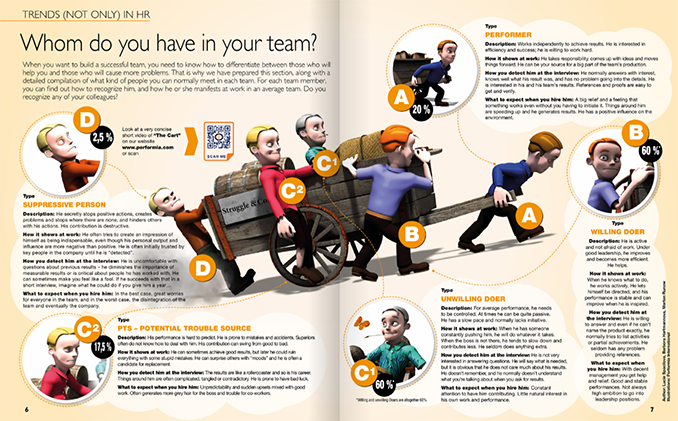
Whom do you have in your team?
When you want to build a successful team, you need to know how to differentiate between those who will help you and those who will cause more problems. That is why we have prepared this section, along with a detailed compilation of what kind of people you can normally meet in each team. For each team member, you can find out how to recognize him, and how he or she manifests at work in an average team. Do you recognize any of your colleagues?
Type D – Suppressive person
2,5%
Description: He secretly stops positive actions, creates problems and stops where there are none, and hinders others
with his actions. His contribution is destructive.
How it shows at work: He often tries to create an impression of himself as being indispensable, even though his personal output and influence are more negative than positive. He is often initially trusted by key people in the company until he is “detected”.
How you detect him at the interview: He is uncomfortable with questions about previous results – he diminishes the importance of measurable results or is critical about people he has worked with. He can sometimes make you feel like a fool. If he succeeds with that in a short interview, imagine what he could do if you give him a year…
What to expect when you hire him: In the best case, great worries for everyone in the team, and in the worst case, the disintegration of the team and eventually the company.
Type C2 – PTS – Potential trouble source
17,5%
Description: performance is hard to predict. He is prone to mistakes and accidents. Superiors often do not know how to deal with him. His contribution can swing from good to bad.
How it shows at work: He can sometimes achieve good results, but later he could ruin everything with some stupid mistakes. He can surprise others with “moods” and he is often a candidate for replacement.
How you detect him at the interview: The results are like a rollercoaster and so is his career. Things around him are often complicated, tangled or contradictory. He is prone to have bad luck.
What to expect when you hire him: Unpredictability and sudden upsets mixed with good work. Often generates more grey hair for the boss and trouble for co-workers.
Type A – Performer
20%
Description: Works independently to achieve results. He is interested in efficiency and success; he is willing to work hard.
How it shows at work: He takes responsibility, comes up with ideas and moves things forward. He can be your source for a big part of the team’s production.
How you detect him at the interview: He normally answers with interest, knows well what his result was, and has no problem going into the details. He is interested in his and his team’s results. References and proofs are easy to get and verify.
What to expect when you hire him: A big relief and a feeling that something works even without you having to initiate it. Things around him are speeding up and he generates results. He has a positive influence on the environment.
Type C1 – Unwilling Doer
60%
Description: For average performance, he needs to be controlled. At times he can be quite passive. He has a slow pace and normally lacks initiative.
How it shows at work: When he has someone constantly pushing him, he will do whatever it takes. When the boss is not there, he tends to slow down and contributes less. He seldom does anything extra.
How you detect him at the interview: He is not very interested in answering questions. He will say what is needed, but it is obvious that he does not care much about his results. He doesn’t remember, and he normally doesn’t understand what you’re talking about when you ask for results.
What to expect when you hire him: Constant attention to have him contributing. Little natural interest in his own work and performance.
Type B – Willing Doer
60%
Description: He is active and not afraid of work. Under good leadership, he improves and becomes more efficient. He helps.
How it shows at work: When he knows what to do, he works actively. He lets himself be directed, and his performance is stable and can improve when he is inspired.
How you detect him at the interview: He is willing to answer and even if he can’t name the product exactly, he normally tries to list activities or partial achievements. He seldom has any problem providing references.
What to expect when you hire him:With decent management you get help and relief. Good and stable performances. Not always high ambition to go into leadership positions.